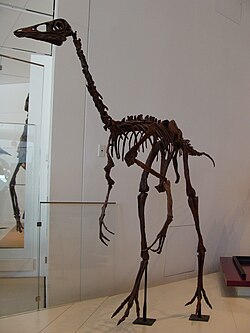Ornithomimus
|
Ornithomimus Temporal range: Late Cretaceous, 76.5–66.5 Ma |
|
|---|---|
 |
|
| Mounted O. edmontonicus skeleton, Royal Ontario Museum | |
| Scientific classification | |
| Kingdom: | Animalia |
| Phylum: | Chordata |
| Class: | Reptilia |
| Clade: | Dinosauria |
| Order: | Saurischia |
| Suborder: | Theropoda |
| Clade: | †Ornithomimosauria |
| Family: | †Ornithomimidae |
| Genus: |
†Ornithomimus Marsh, 1890 |
| Type species | |
|
†Ornithomimus velox Marsh, 1890 |
|
| Other species | |
|
†O. edmontonicus |
|
| Synonyms | |
|
Dromiceiomimus? Russell, 1972 |
|
†O. edmontonicus
Sternberg, 1933
†O. samueli?
(Parks, 1928)
Dromiceiomimus? Russell, 1972
Ornithomimus (/ˌɔːrnᵻθəˈmaɪməs, -θoʊ-/; "bird mimic") is a genus of ornithomimid dinosaurs from the Late Cretaceous Period of what is now North America. Ornithomimus was a swift bipedal theropod which fossil evidence indicates was covered in feathers, equipped with a small toothless beak that may indicate an omnivorous diet. It is usually classified into two species: the type species, Ornithomimus velox, and a referred species, Ornithomimus edmontonicus. O. velox was named in 1890 by Othniel Charles Marsh on the basis of a foot and partial hand from the late Maastrichtian-age Denver Formation of Colorado, United States. Another seventeen species have been named since, though most of them have subsequently been assigned to new genera or shown to be not directly related to Ornithomimus velox. The best material of species still considered part of the genus has been found in Alberta, Canada, representing the species O. edmontonicus, known from several skeletons from the early Maastrichtian Horseshoe Canyon Formation. Additional species and specimens from other formations are sometimes classified as Ornithomimus, such as Ornithomimus samueli (alternately classified in the genera Dromiceiomimus or Struthiomimus) from the earlier, Campanian-age Dinosaur Park Formation of Alberta.
...
Wikipedia
